Human Resource Management Report: Task and Analysis
VerifiedAdded on 2020/02/05
|22
|5662
|854
Report
AI Summary
This report provides a comprehensive analysis of Human Resource Management (HRM), addressing key aspects such as recruitment, selection, training, and employee relations. The report begins by defining HRM and its primary roles, contrasting the "Best Fit" and "Best Practices" approaches. Part 1 focuses on recruitment and selection, exploring internal and external recruitment methods and selection processes, using Woodhill College as a case study. Part 2 delves into training and development, examining the differences between the two, and exploring how changes in customer expectations impact training needs, particularly in the context of Tesco. The report also covers coaching methods, training needs identification, the benefits of structured training programs, and approaches to flexibility. Furthermore, the report analyzes the importance of maintaining good employee relations, especially for ITV, and identifies key elements of employment legislation and their influence on HR decisions. The conclusion summarizes the key findings, and the report includes a list of references.
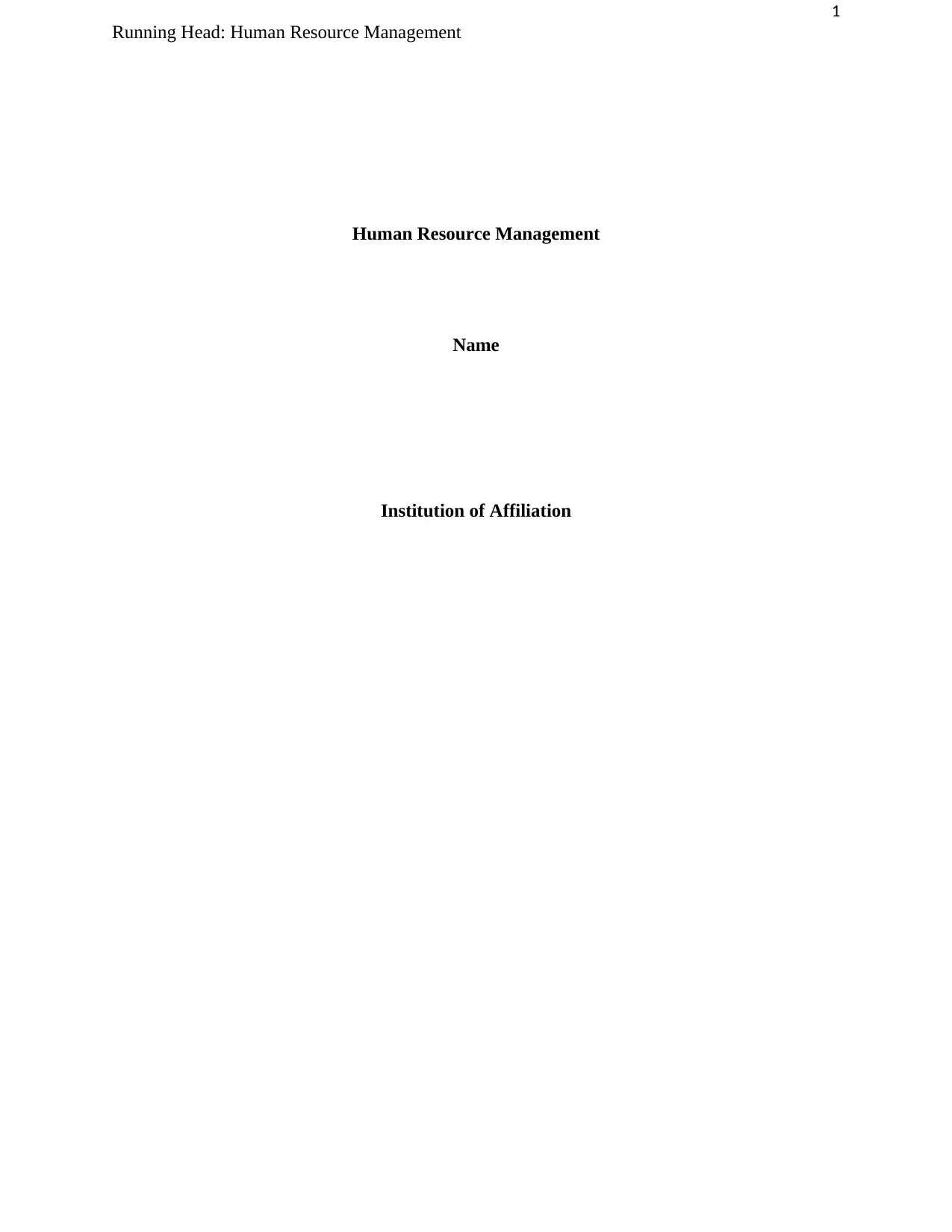
1
Running Head: Human Resource Management
Human Resource Management
Name
Institution of Affiliation
Running Head: Human Resource Management
Human Resource Management
Name
Institution of Affiliation
Paraphrase This Document
Need a fresh take? Get an instant paraphrase of this document with our AI Paraphraser
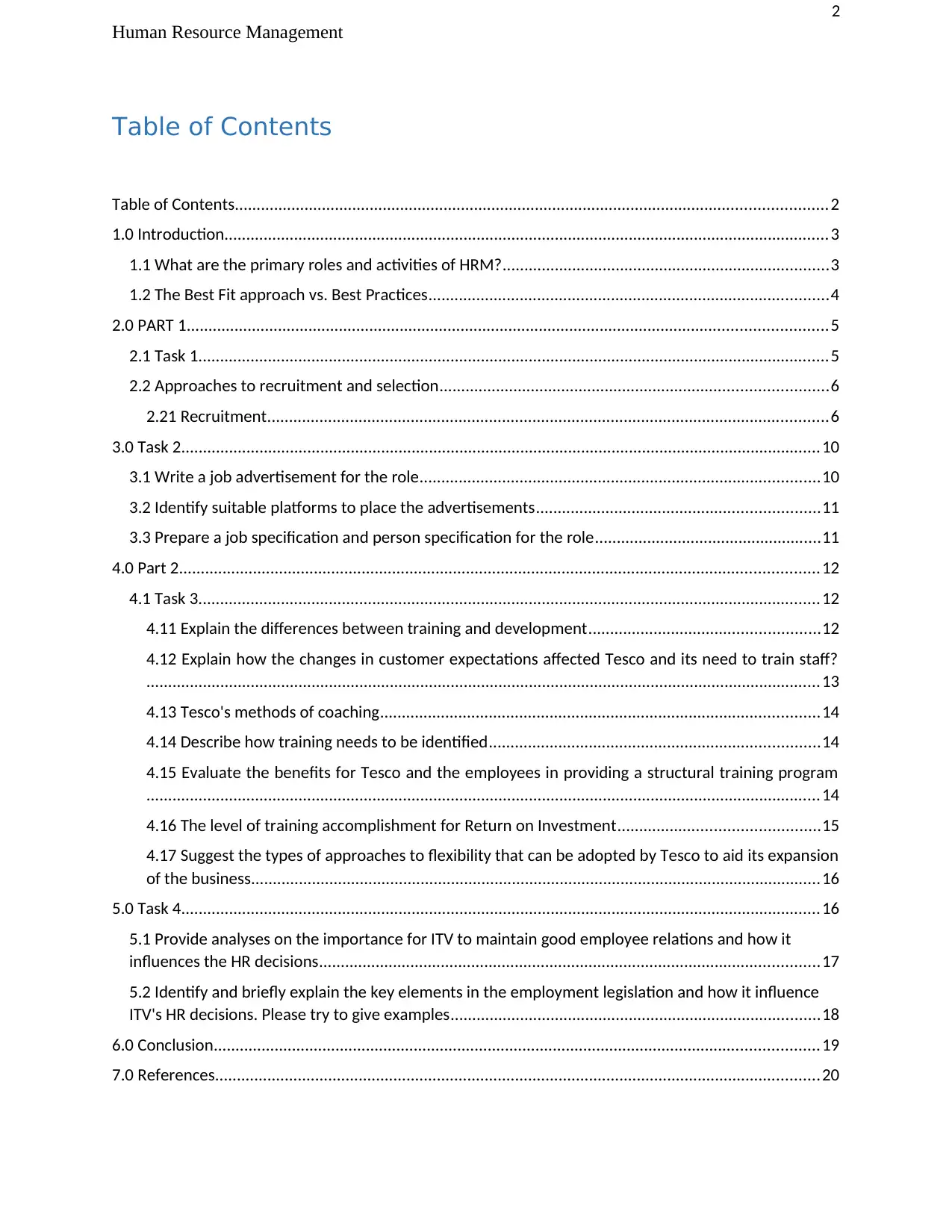
2
Human Resource Management
Table of Contents
Table of Contents........................................................................................................................................2
1.0 Introduction...........................................................................................................................................3
1.1 What are the primary roles and activities of HRM?...........................................................................3
1.2 The Best Fit approach vs. Best Practices............................................................................................4
2.0 PART 1...................................................................................................................................................5
2.1 Task 1.................................................................................................................................................5
2.2 Approaches to recruitment and selection.........................................................................................6
2.21 Recruitment.................................................................................................................................6
3.0 Task 2...................................................................................................................................................10
3.1 Write a job advertisement for the role............................................................................................10
3.2 Identify suitable platforms to place the advertisements.................................................................11
3.3 Prepare a job specification and person specification for the role....................................................11
4.0 Part 2...................................................................................................................................................12
4.1 Task 3...............................................................................................................................................12
4.11 Explain the differences between training and development.....................................................12
4.12 Explain how the changes in customer expectations affected Tesco and its need to train staff?
...........................................................................................................................................................13
4.13 Tesco's methods of coaching.....................................................................................................14
4.14 Describe how training needs to be identified............................................................................14
4.15 Evaluate the benefits for Tesco and the employees in providing a structural training program
...........................................................................................................................................................14
4.16 The level of training accomplishment for Return on Investment..............................................15
4.17 Suggest the types of approaches to flexibility that can be adopted by Tesco to aid its expansion
of the business...................................................................................................................................16
5.0 Task 4...................................................................................................................................................16
5.1 Provide analyses on the importance for ITV to maintain good employee relations and how it
influences the HR decisions...................................................................................................................17
5.2 Identify and briefly explain the key elements in the employment legislation and how it influence
ITV's HR decisions. Please try to give examples.....................................................................................18
6.0 Conclusion...........................................................................................................................................19
7.0 References...........................................................................................................................................20
Human Resource Management
Table of Contents
Table of Contents........................................................................................................................................2
1.0 Introduction...........................................................................................................................................3
1.1 What are the primary roles and activities of HRM?...........................................................................3
1.2 The Best Fit approach vs. Best Practices............................................................................................4
2.0 PART 1...................................................................................................................................................5
2.1 Task 1.................................................................................................................................................5
2.2 Approaches to recruitment and selection.........................................................................................6
2.21 Recruitment.................................................................................................................................6
3.0 Task 2...................................................................................................................................................10
3.1 Write a job advertisement for the role............................................................................................10
3.2 Identify suitable platforms to place the advertisements.................................................................11
3.3 Prepare a job specification and person specification for the role....................................................11
4.0 Part 2...................................................................................................................................................12
4.1 Task 3...............................................................................................................................................12
4.11 Explain the differences between training and development.....................................................12
4.12 Explain how the changes in customer expectations affected Tesco and its need to train staff?
...........................................................................................................................................................13
4.13 Tesco's methods of coaching.....................................................................................................14
4.14 Describe how training needs to be identified............................................................................14
4.15 Evaluate the benefits for Tesco and the employees in providing a structural training program
...........................................................................................................................................................14
4.16 The level of training accomplishment for Return on Investment..............................................15
4.17 Suggest the types of approaches to flexibility that can be adopted by Tesco to aid its expansion
of the business...................................................................................................................................16
5.0 Task 4...................................................................................................................................................16
5.1 Provide analyses on the importance for ITV to maintain good employee relations and how it
influences the HR decisions...................................................................................................................17
5.2 Identify and briefly explain the key elements in the employment legislation and how it influence
ITV's HR decisions. Please try to give examples.....................................................................................18
6.0 Conclusion...........................................................................................................................................19
7.0 References...........................................................................................................................................20
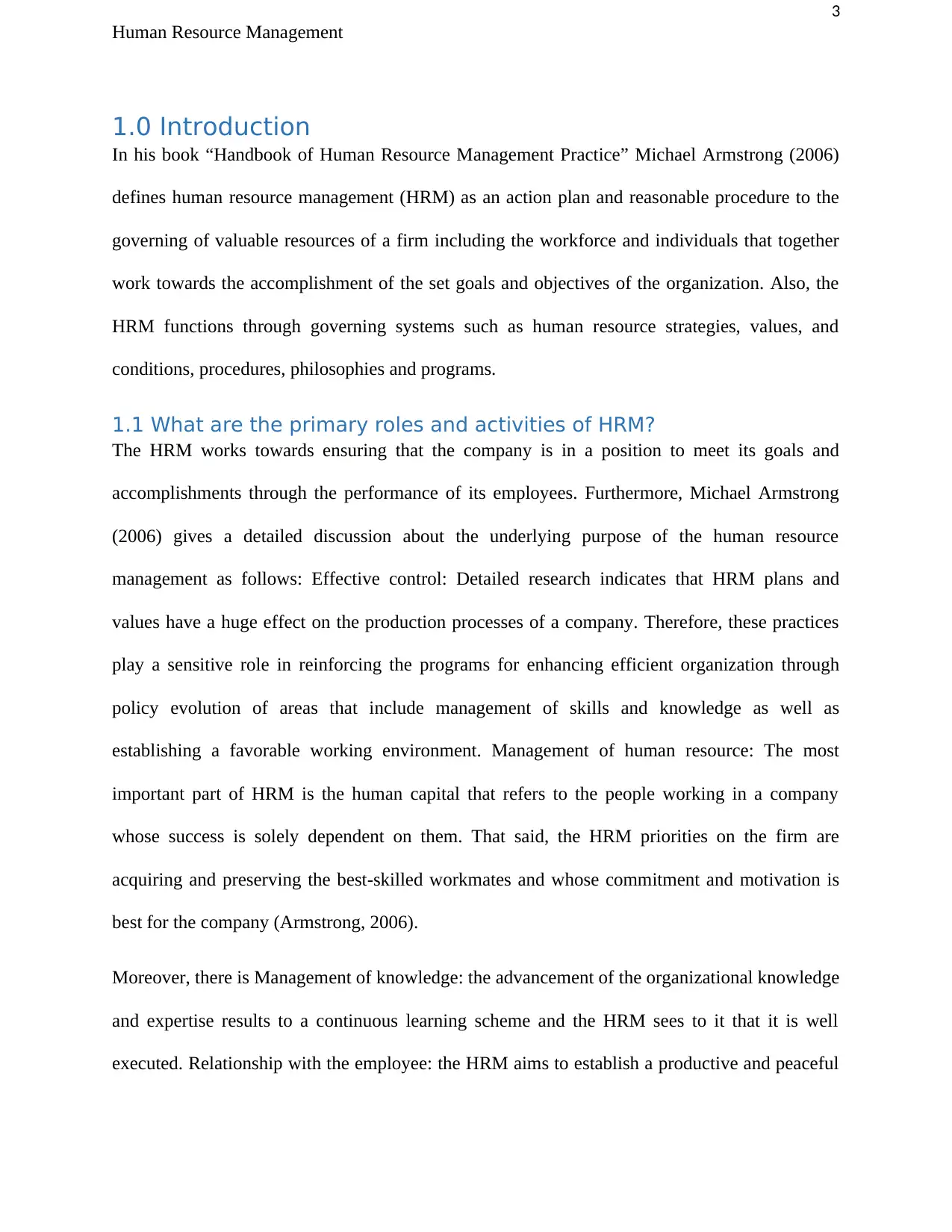
3
Human Resource Management
1.0 Introduction
In his book “Handbook of Human Resource Management Practice” Michael Armstrong (2006)
defines human resource management (HRM) as an action plan and reasonable procedure to the
governing of valuable resources of a firm including the workforce and individuals that together
work towards the accomplishment of the set goals and objectives of the organization. Also, the
HRM functions through governing systems such as human resource strategies, values, and
conditions, procedures, philosophies and programs.
1.1 What are the primary roles and activities of HRM?
The HRM works towards ensuring that the company is in a position to meet its goals and
accomplishments through the performance of its employees. Furthermore, Michael Armstrong
(2006) gives a detailed discussion about the underlying purpose of the human resource
management as follows: Effective control: Detailed research indicates that HRM plans and
values have a huge effect on the production processes of a company. Therefore, these practices
play a sensitive role in reinforcing the programs for enhancing efficient organization through
policy evolution of areas that include management of skills and knowledge as well as
establishing a favorable working environment. Management of human resource: The most
important part of HRM is the human capital that refers to the people working in a company
whose success is solely dependent on them. That said, the HRM priorities on the firm are
acquiring and preserving the best-skilled workmates and whose commitment and motivation is
best for the company (Armstrong, 2006).
Moreover, there is Management of knowledge: the advancement of the organizational knowledge
and expertise results to a continuous learning scheme and the HRM sees to it that it is well
executed. Relationship with the employee: the HRM aims to establish a productive and peaceful
Human Resource Management
1.0 Introduction
In his book “Handbook of Human Resource Management Practice” Michael Armstrong (2006)
defines human resource management (HRM) as an action plan and reasonable procedure to the
governing of valuable resources of a firm including the workforce and individuals that together
work towards the accomplishment of the set goals and objectives of the organization. Also, the
HRM functions through governing systems such as human resource strategies, values, and
conditions, procedures, philosophies and programs.
1.1 What are the primary roles and activities of HRM?
The HRM works towards ensuring that the company is in a position to meet its goals and
accomplishments through the performance of its employees. Furthermore, Michael Armstrong
(2006) gives a detailed discussion about the underlying purpose of the human resource
management as follows: Effective control: Detailed research indicates that HRM plans and
values have a huge effect on the production processes of a company. Therefore, these practices
play a sensitive role in reinforcing the programs for enhancing efficient organization through
policy evolution of areas that include management of skills and knowledge as well as
establishing a favorable working environment. Management of human resource: The most
important part of HRM is the human capital that refers to the people working in a company
whose success is solely dependent on them. That said, the HRM priorities on the firm are
acquiring and preserving the best-skilled workmates and whose commitment and motivation is
best for the company (Armstrong, 2006).
Moreover, there is Management of knowledge: the advancement of the organizational knowledge
and expertise results to a continuous learning scheme and the HRM sees to it that it is well
executed. Relationship with the employee: the HRM aims to establish a productive and peaceful
⊘ This is a preview!⊘
Do you want full access?
Subscribe today to unlock all pages.

Trusted by 1+ million students worldwide
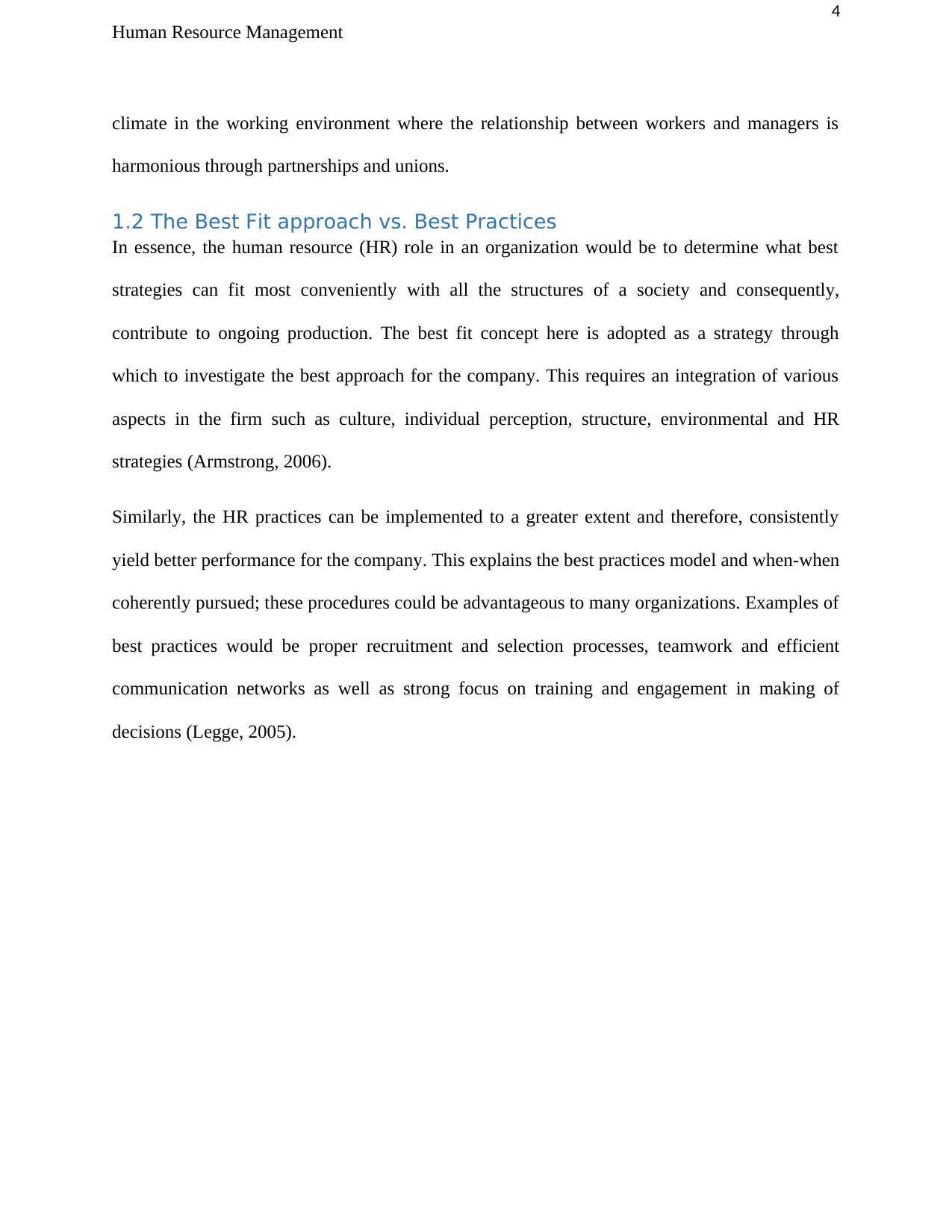
4
Human Resource Management
climate in the working environment where the relationship between workers and managers is
harmonious through partnerships and unions.
1.2 The Best Fit approach vs. Best Practices
In essence, the human resource (HR) role in an organization would be to determine what best
strategies can fit most conveniently with all the structures of a society and consequently,
contribute to ongoing production. The best fit concept here is adopted as a strategy through
which to investigate the best approach for the company. This requires an integration of various
aspects in the firm such as culture, individual perception, structure, environmental and HR
strategies (Armstrong, 2006).
Similarly, the HR practices can be implemented to a greater extent and therefore, consistently
yield better performance for the company. This explains the best practices model and when-when
coherently pursued; these procedures could be advantageous to many organizations. Examples of
best practices would be proper recruitment and selection processes, teamwork and efficient
communication networks as well as strong focus on training and engagement in making of
decisions (Legge, 2005).
Human Resource Management
climate in the working environment where the relationship between workers and managers is
harmonious through partnerships and unions.
1.2 The Best Fit approach vs. Best Practices
In essence, the human resource (HR) role in an organization would be to determine what best
strategies can fit most conveniently with all the structures of a society and consequently,
contribute to ongoing production. The best fit concept here is adopted as a strategy through
which to investigate the best approach for the company. This requires an integration of various
aspects in the firm such as culture, individual perception, structure, environmental and HR
strategies (Armstrong, 2006).
Similarly, the HR practices can be implemented to a greater extent and therefore, consistently
yield better performance for the company. This explains the best practices model and when-when
coherently pursued; these procedures could be advantageous to many organizations. Examples of
best practices would be proper recruitment and selection processes, teamwork and efficient
communication networks as well as strong focus on training and engagement in making of
decisions (Legge, 2005).
Paraphrase This Document
Need a fresh take? Get an instant paraphrase of this document with our AI Paraphraser
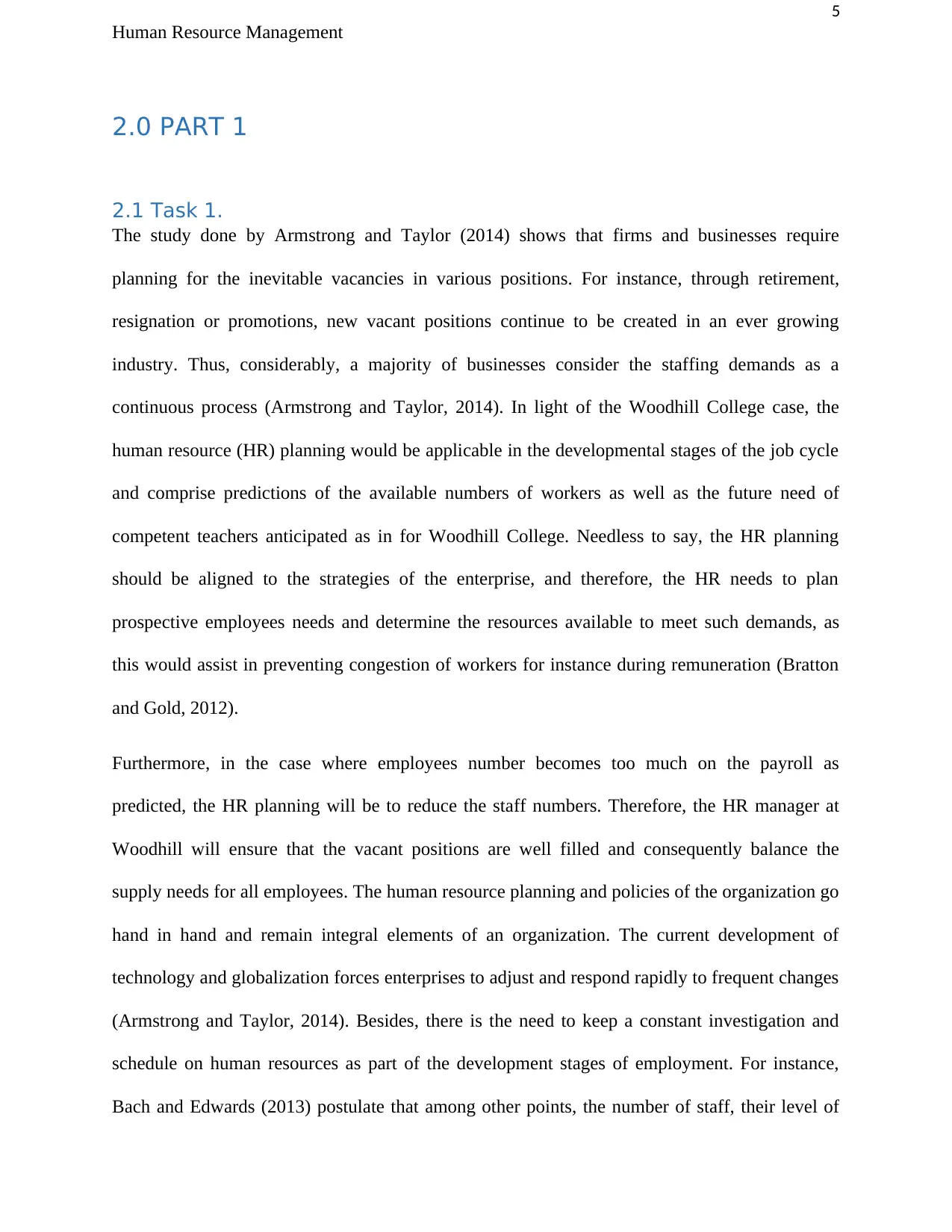
5
Human Resource Management
2.0 PART 1
2.1 Task 1.
The study done by Armstrong and Taylor (2014) shows that firms and businesses require
planning for the inevitable vacancies in various positions. For instance, through retirement,
resignation or promotions, new vacant positions continue to be created in an ever growing
industry. Thus, considerably, a majority of businesses consider the staffing demands as a
continuous process (Armstrong and Taylor, 2014). In light of the Woodhill College case, the
human resource (HR) planning would be applicable in the developmental stages of the job cycle
and comprise predictions of the available numbers of workers as well as the future need of
competent teachers anticipated as in for Woodhill College. Needless to say, the HR planning
should be aligned to the strategies of the enterprise, and therefore, the HR needs to plan
prospective employees needs and determine the resources available to meet such demands, as
this would assist in preventing congestion of workers for instance during remuneration (Bratton
and Gold, 2012).
Furthermore, in the case where employees number becomes too much on the payroll as
predicted, the HR planning will be to reduce the staff numbers. Therefore, the HR manager at
Woodhill will ensure that the vacant positions are well filled and consequently balance the
supply needs for all employees. The human resource planning and policies of the organization go
hand in hand and remain integral elements of an organization. The current development of
technology and globalization forces enterprises to adjust and respond rapidly to frequent changes
(Armstrong and Taylor, 2014). Besides, there is the need to keep a constant investigation and
schedule on human resources as part of the development stages of employment. For instance,
Bach and Edwards (2013) postulate that among other points, the number of staff, their level of
Human Resource Management
2.0 PART 1
2.1 Task 1.
The study done by Armstrong and Taylor (2014) shows that firms and businesses require
planning for the inevitable vacancies in various positions. For instance, through retirement,
resignation or promotions, new vacant positions continue to be created in an ever growing
industry. Thus, considerably, a majority of businesses consider the staffing demands as a
continuous process (Armstrong and Taylor, 2014). In light of the Woodhill College case, the
human resource (HR) planning would be applicable in the developmental stages of the job cycle
and comprise predictions of the available numbers of workers as well as the future need of
competent teachers anticipated as in for Woodhill College. Needless to say, the HR planning
should be aligned to the strategies of the enterprise, and therefore, the HR needs to plan
prospective employees needs and determine the resources available to meet such demands, as
this would assist in preventing congestion of workers for instance during remuneration (Bratton
and Gold, 2012).
Furthermore, in the case where employees number becomes too much on the payroll as
predicted, the HR planning will be to reduce the staff numbers. Therefore, the HR manager at
Woodhill will ensure that the vacant positions are well filled and consequently balance the
supply needs for all employees. The human resource planning and policies of the organization go
hand in hand and remain integral elements of an organization. The current development of
technology and globalization forces enterprises to adjust and respond rapidly to frequent changes
(Armstrong and Taylor, 2014). Besides, there is the need to keep a constant investigation and
schedule on human resources as part of the development stages of employment. For instance,
Bach and Edwards (2013) postulate that among other points, the number of staff, their level of
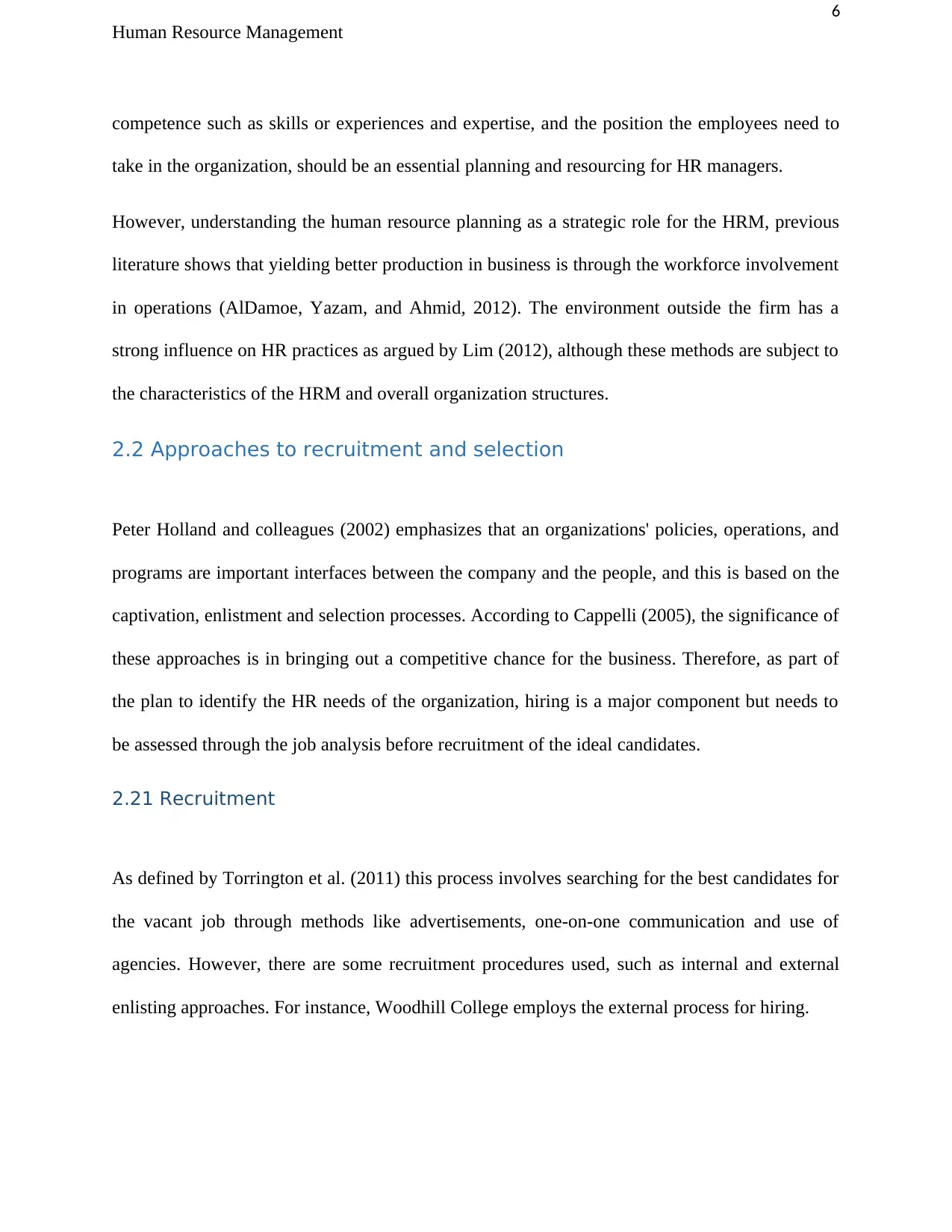
6
Human Resource Management
competence such as skills or experiences and expertise, and the position the employees need to
take in the organization, should be an essential planning and resourcing for HR managers.
However, understanding the human resource planning as a strategic role for the HRM, previous
literature shows that yielding better production in business is through the workforce involvement
in operations (AlDamoe, Yazam, and Ahmid, 2012). The environment outside the firm has a
strong influence on HR practices as argued by Lim (2012), although these methods are subject to
the characteristics of the HRM and overall organization structures.
2.2 Approaches to recruitment and selection
Peter Holland and colleagues (2002) emphasizes that an organizations' policies, operations, and
programs are important interfaces between the company and the people, and this is based on the
captivation, enlistment and selection processes. According to Cappelli (2005), the significance of
these approaches is in bringing out a competitive chance for the business. Therefore, as part of
the plan to identify the HR needs of the organization, hiring is a major component but needs to
be assessed through the job analysis before recruitment of the ideal candidates.
2.21 Recruitment
As defined by Torrington et al. (2011) this process involves searching for the best candidates for
the vacant job through methods like advertisements, one-on-one communication and use of
agencies. However, there are some recruitment procedures used, such as internal and external
enlisting approaches. For instance, Woodhill College employs the external process for hiring.
Human Resource Management
competence such as skills or experiences and expertise, and the position the employees need to
take in the organization, should be an essential planning and resourcing for HR managers.
However, understanding the human resource planning as a strategic role for the HRM, previous
literature shows that yielding better production in business is through the workforce involvement
in operations (AlDamoe, Yazam, and Ahmid, 2012). The environment outside the firm has a
strong influence on HR practices as argued by Lim (2012), although these methods are subject to
the characteristics of the HRM and overall organization structures.
2.2 Approaches to recruitment and selection
Peter Holland and colleagues (2002) emphasizes that an organizations' policies, operations, and
programs are important interfaces between the company and the people, and this is based on the
captivation, enlistment and selection processes. According to Cappelli (2005), the significance of
these approaches is in bringing out a competitive chance for the business. Therefore, as part of
the plan to identify the HR needs of the organization, hiring is a major component but needs to
be assessed through the job analysis before recruitment of the ideal candidates.
2.21 Recruitment
As defined by Torrington et al. (2011) this process involves searching for the best candidates for
the vacant job through methods like advertisements, one-on-one communication and use of
agencies. However, there are some recruitment procedures used, such as internal and external
enlisting approaches. For instance, Woodhill College employs the external process for hiring.
⊘ This is a preview!⊘
Do you want full access?
Subscribe today to unlock all pages.

Trusted by 1+ million students worldwide
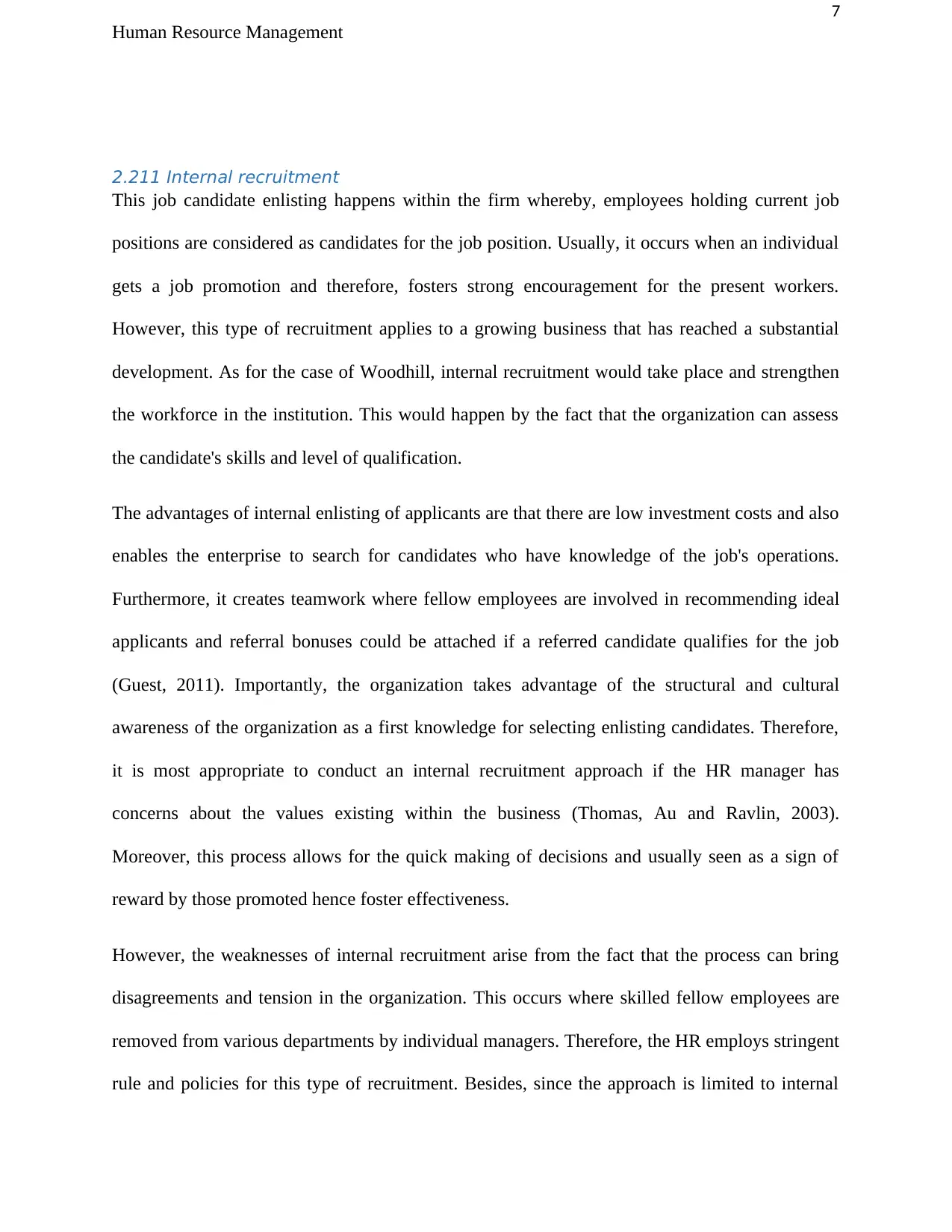
7
Human Resource Management
2.211 Internal recruitment
This job candidate enlisting happens within the firm whereby, employees holding current job
positions are considered as candidates for the job position. Usually, it occurs when an individual
gets a job promotion and therefore, fosters strong encouragement for the present workers.
However, this type of recruitment applies to a growing business that has reached a substantial
development. As for the case of Woodhill, internal recruitment would take place and strengthen
the workforce in the institution. This would happen by the fact that the organization can assess
the candidate's skills and level of qualification.
The advantages of internal enlisting of applicants are that there are low investment costs and also
enables the enterprise to search for candidates who have knowledge of the job's operations.
Furthermore, it creates teamwork where fellow employees are involved in recommending ideal
applicants and referral bonuses could be attached if a referred candidate qualifies for the job
(Guest, 2011). Importantly, the organization takes advantage of the structural and cultural
awareness of the organization as a first knowledge for selecting enlisting candidates. Therefore,
it is most appropriate to conduct an internal recruitment approach if the HR manager has
concerns about the values existing within the business (Thomas, Au and Ravlin, 2003).
Moreover, this process allows for the quick making of decisions and usually seen as a sign of
reward by those promoted hence foster effectiveness.
However, the weaknesses of internal recruitment arise from the fact that the process can bring
disagreements and tension in the organization. This occurs where skilled fellow employees are
removed from various departments by individual managers. Therefore, the HR employs stringent
rule and policies for this type of recruitment. Besides, since the approach is limited to internal
Human Resource Management
2.211 Internal recruitment
This job candidate enlisting happens within the firm whereby, employees holding current job
positions are considered as candidates for the job position. Usually, it occurs when an individual
gets a job promotion and therefore, fosters strong encouragement for the present workers.
However, this type of recruitment applies to a growing business that has reached a substantial
development. As for the case of Woodhill, internal recruitment would take place and strengthen
the workforce in the institution. This would happen by the fact that the organization can assess
the candidate's skills and level of qualification.
The advantages of internal enlisting of applicants are that there are low investment costs and also
enables the enterprise to search for candidates who have knowledge of the job's operations.
Furthermore, it creates teamwork where fellow employees are involved in recommending ideal
applicants and referral bonuses could be attached if a referred candidate qualifies for the job
(Guest, 2011). Importantly, the organization takes advantage of the structural and cultural
awareness of the organization as a first knowledge for selecting enlisting candidates. Therefore,
it is most appropriate to conduct an internal recruitment approach if the HR manager has
concerns about the values existing within the business (Thomas, Au and Ravlin, 2003).
Moreover, this process allows for the quick making of decisions and usually seen as a sign of
reward by those promoted hence foster effectiveness.
However, the weaknesses of internal recruitment arise from the fact that the process can bring
disagreements and tension in the organization. This occurs where skilled fellow employees are
removed from various departments by individual managers. Therefore, the HR employs stringent
rule and policies for this type of recruitment. Besides, since the approach is limited to internal
Paraphrase This Document
Need a fresh take? Get an instant paraphrase of this document with our AI Paraphraser
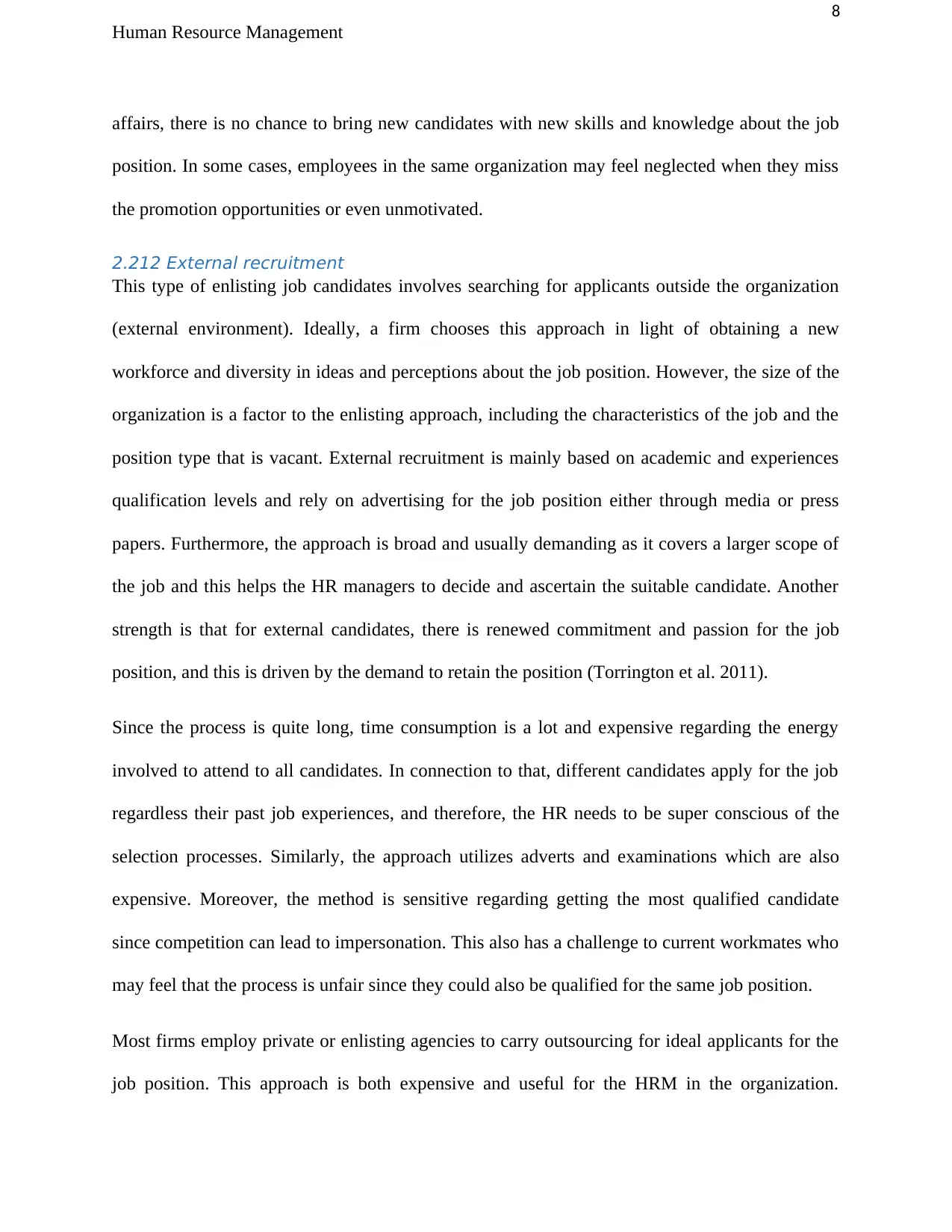
8
Human Resource Management
affairs, there is no chance to bring new candidates with new skills and knowledge about the job
position. In some cases, employees in the same organization may feel neglected when they miss
the promotion opportunities or even unmotivated.
2.212 External recruitment
This type of enlisting job candidates involves searching for applicants outside the organization
(external environment). Ideally, a firm chooses this approach in light of obtaining a new
workforce and diversity in ideas and perceptions about the job position. However, the size of the
organization is a factor to the enlisting approach, including the characteristics of the job and the
position type that is vacant. External recruitment is mainly based on academic and experiences
qualification levels and rely on advertising for the job position either through media or press
papers. Furthermore, the approach is broad and usually demanding as it covers a larger scope of
the job and this helps the HR managers to decide and ascertain the suitable candidate. Another
strength is that for external candidates, there is renewed commitment and passion for the job
position, and this is driven by the demand to retain the position (Torrington et al. 2011).
Since the process is quite long, time consumption is a lot and expensive regarding the energy
involved to attend to all candidates. In connection to that, different candidates apply for the job
regardless their past job experiences, and therefore, the HR needs to be super conscious of the
selection processes. Similarly, the approach utilizes adverts and examinations which are also
expensive. Moreover, the method is sensitive regarding getting the most qualified candidate
since competition can lead to impersonation. This also has a challenge to current workmates who
may feel that the process is unfair since they could also be qualified for the same job position.
Most firms employ private or enlisting agencies to carry outsourcing for ideal applicants for the
job position. This approach is both expensive and useful for the HRM in the organization.
Human Resource Management
affairs, there is no chance to bring new candidates with new skills and knowledge about the job
position. In some cases, employees in the same organization may feel neglected when they miss
the promotion opportunities or even unmotivated.
2.212 External recruitment
This type of enlisting job candidates involves searching for applicants outside the organization
(external environment). Ideally, a firm chooses this approach in light of obtaining a new
workforce and diversity in ideas and perceptions about the job position. However, the size of the
organization is a factor to the enlisting approach, including the characteristics of the job and the
position type that is vacant. External recruitment is mainly based on academic and experiences
qualification levels and rely on advertising for the job position either through media or press
papers. Furthermore, the approach is broad and usually demanding as it covers a larger scope of
the job and this helps the HR managers to decide and ascertain the suitable candidate. Another
strength is that for external candidates, there is renewed commitment and passion for the job
position, and this is driven by the demand to retain the position (Torrington et al. 2011).
Since the process is quite long, time consumption is a lot and expensive regarding the energy
involved to attend to all candidates. In connection to that, different candidates apply for the job
regardless their past job experiences, and therefore, the HR needs to be super conscious of the
selection processes. Similarly, the approach utilizes adverts and examinations which are also
expensive. Moreover, the method is sensitive regarding getting the most qualified candidate
since competition can lead to impersonation. This also has a challenge to current workmates who
may feel that the process is unfair since they could also be qualified for the same job position.
Most firms employ private or enlisting agencies to carry outsourcing for ideal applicants for the
job position. This approach is both expensive and useful for the HRM in the organization.
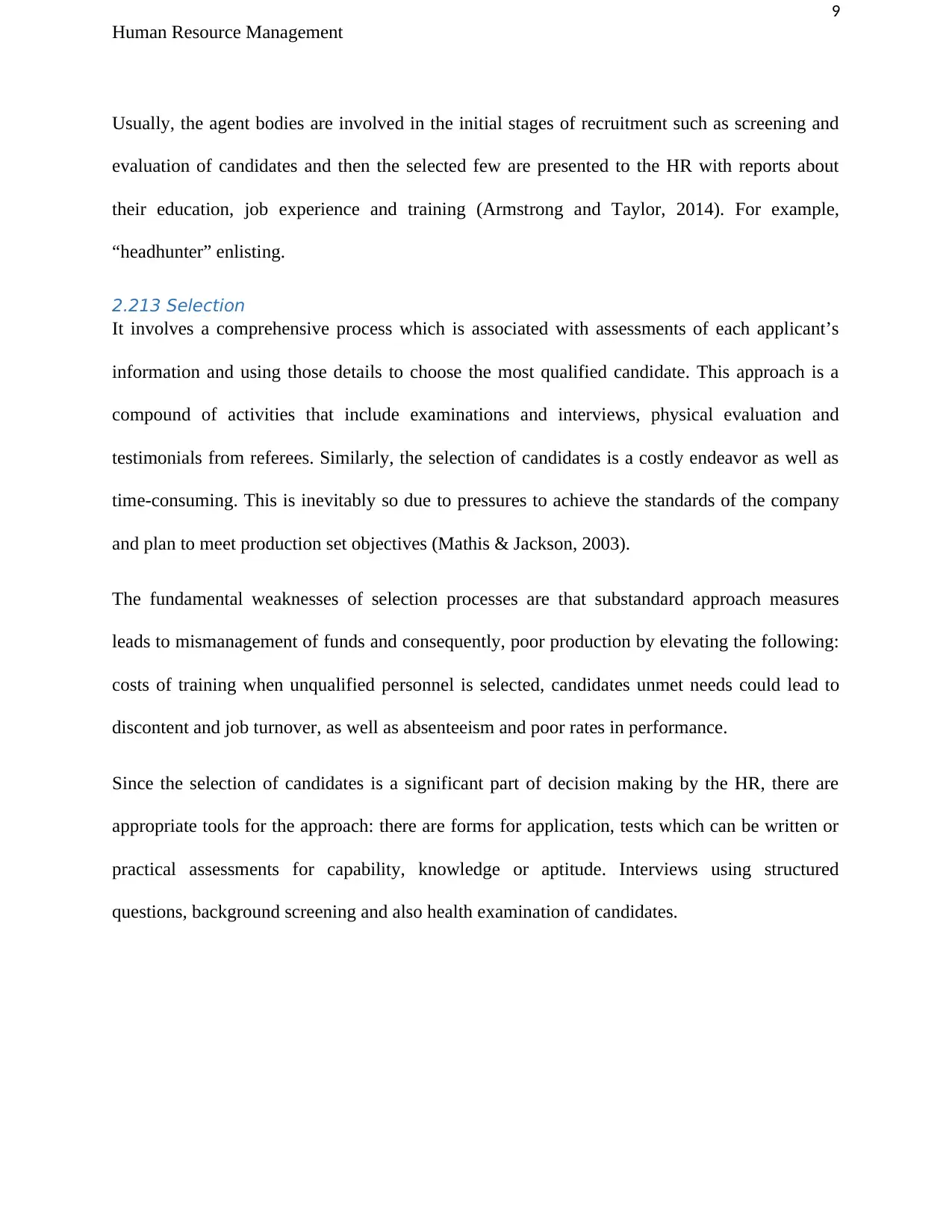
9
Human Resource Management
Usually, the agent bodies are involved in the initial stages of recruitment such as screening and
evaluation of candidates and then the selected few are presented to the HR with reports about
their education, job experience and training (Armstrong and Taylor, 2014). For example,
“headhunter” enlisting.
2.213 Selection
It involves a comprehensive process which is associated with assessments of each applicant’s
information and using those details to choose the most qualified candidate. This approach is a
compound of activities that include examinations and interviews, physical evaluation and
testimonials from referees. Similarly, the selection of candidates is a costly endeavor as well as
time-consuming. This is inevitably so due to pressures to achieve the standards of the company
and plan to meet production set objectives (Mathis & Jackson, 2003).
The fundamental weaknesses of selection processes are that substandard approach measures
leads to mismanagement of funds and consequently, poor production by elevating the following:
costs of training when unqualified personnel is selected, candidates unmet needs could lead to
discontent and job turnover, as well as absenteeism and poor rates in performance.
Since the selection of candidates is a significant part of decision making by the HR, there are
appropriate tools for the approach: there are forms for application, tests which can be written or
practical assessments for capability, knowledge or aptitude. Interviews using structured
questions, background screening and also health examination of candidates.
Human Resource Management
Usually, the agent bodies are involved in the initial stages of recruitment such as screening and
evaluation of candidates and then the selected few are presented to the HR with reports about
their education, job experience and training (Armstrong and Taylor, 2014). For example,
“headhunter” enlisting.
2.213 Selection
It involves a comprehensive process which is associated with assessments of each applicant’s
information and using those details to choose the most qualified candidate. This approach is a
compound of activities that include examinations and interviews, physical evaluation and
testimonials from referees. Similarly, the selection of candidates is a costly endeavor as well as
time-consuming. This is inevitably so due to pressures to achieve the standards of the company
and plan to meet production set objectives (Mathis & Jackson, 2003).
The fundamental weaknesses of selection processes are that substandard approach measures
leads to mismanagement of funds and consequently, poor production by elevating the following:
costs of training when unqualified personnel is selected, candidates unmet needs could lead to
discontent and job turnover, as well as absenteeism and poor rates in performance.
Since the selection of candidates is a significant part of decision making by the HR, there are
appropriate tools for the approach: there are forms for application, tests which can be written or
practical assessments for capability, knowledge or aptitude. Interviews using structured
questions, background screening and also health examination of candidates.
⊘ This is a preview!⊘
Do you want full access?
Subscribe today to unlock all pages.

Trusted by 1+ million students worldwide
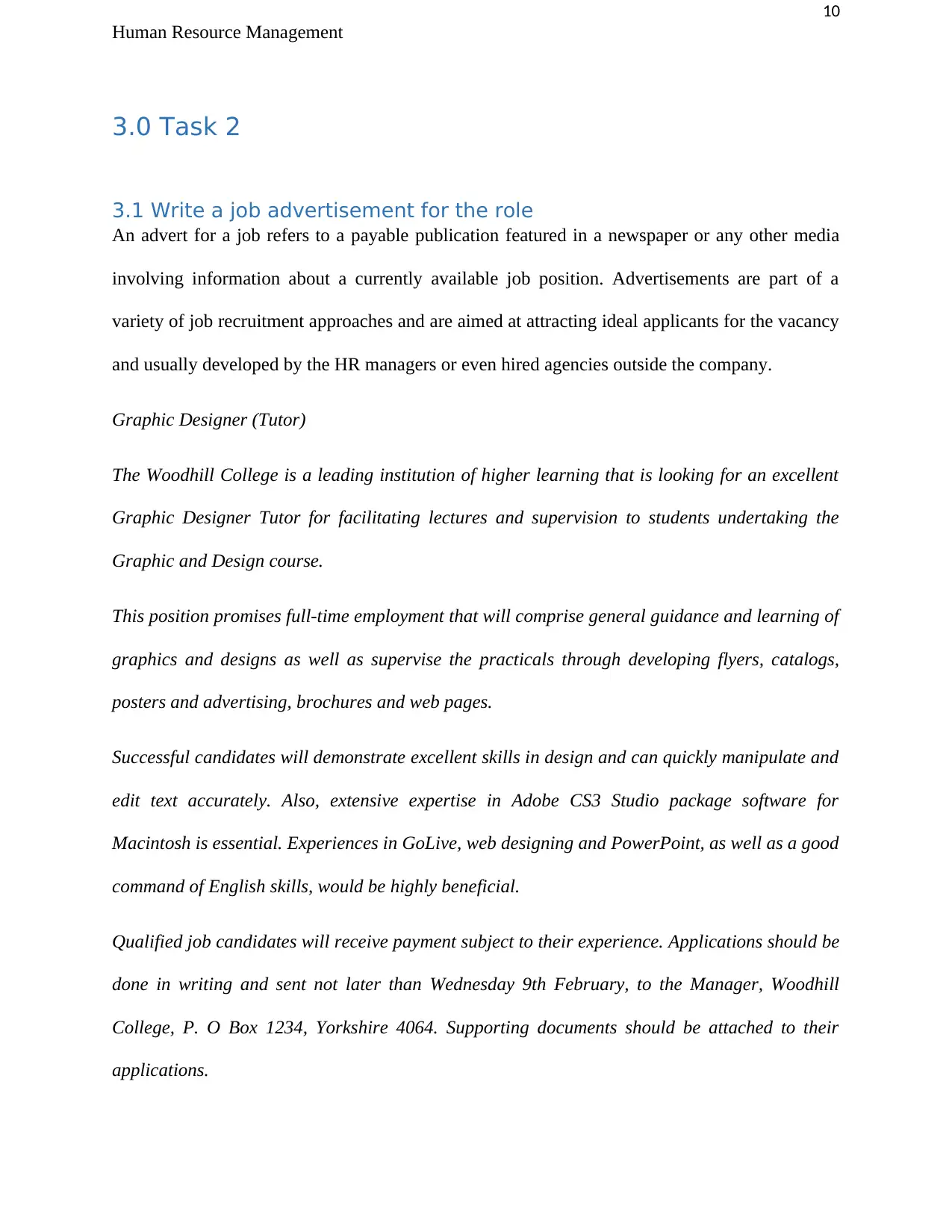
10
Human Resource Management
3.0 Task 2
3.1 Write a job advertisement for the role
An advert for a job refers to a payable publication featured in a newspaper or any other media
involving information about a currently available job position. Advertisements are part of a
variety of job recruitment approaches and are aimed at attracting ideal applicants for the vacancy
and usually developed by the HR managers or even hired agencies outside the company.
Graphic Designer (Tutor)
The Woodhill College is a leading institution of higher learning that is looking for an excellent
Graphic Designer Tutor for facilitating lectures and supervision to students undertaking the
Graphic and Design course.
This position promises full-time employment that will comprise general guidance and learning of
graphics and designs as well as supervise the practicals through developing flyers, catalogs,
posters and advertising, brochures and web pages.
Successful candidates will demonstrate excellent skills in design and can quickly manipulate and
edit text accurately. Also, extensive expertise in Adobe CS3 Studio package software for
Macintosh is essential. Experiences in GoLive, web designing and PowerPoint, as well as a good
command of English skills, would be highly beneficial.
Qualified job candidates will receive payment subject to their experience. Applications should be
done in writing and sent not later than Wednesday 9th February, to the Manager, Woodhill
College, P. O Box 1234, Yorkshire 4064. Supporting documents should be attached to their
applications.
Human Resource Management
3.0 Task 2
3.1 Write a job advertisement for the role
An advert for a job refers to a payable publication featured in a newspaper or any other media
involving information about a currently available job position. Advertisements are part of a
variety of job recruitment approaches and are aimed at attracting ideal applicants for the vacancy
and usually developed by the HR managers or even hired agencies outside the company.
Graphic Designer (Tutor)
The Woodhill College is a leading institution of higher learning that is looking for an excellent
Graphic Designer Tutor for facilitating lectures and supervision to students undertaking the
Graphic and Design course.
This position promises full-time employment that will comprise general guidance and learning of
graphics and designs as well as supervise the practicals through developing flyers, catalogs,
posters and advertising, brochures and web pages.
Successful candidates will demonstrate excellent skills in design and can quickly manipulate and
edit text accurately. Also, extensive expertise in Adobe CS3 Studio package software for
Macintosh is essential. Experiences in GoLive, web designing and PowerPoint, as well as a good
command of English skills, would be highly beneficial.
Qualified job candidates will receive payment subject to their experience. Applications should be
done in writing and sent not later than Wednesday 9th February, to the Manager, Woodhill
College, P. O Box 1234, Yorkshire 4064. Supporting documents should be attached to their
applications.
Paraphrase This Document
Need a fresh take? Get an instant paraphrase of this document with our AI Paraphraser
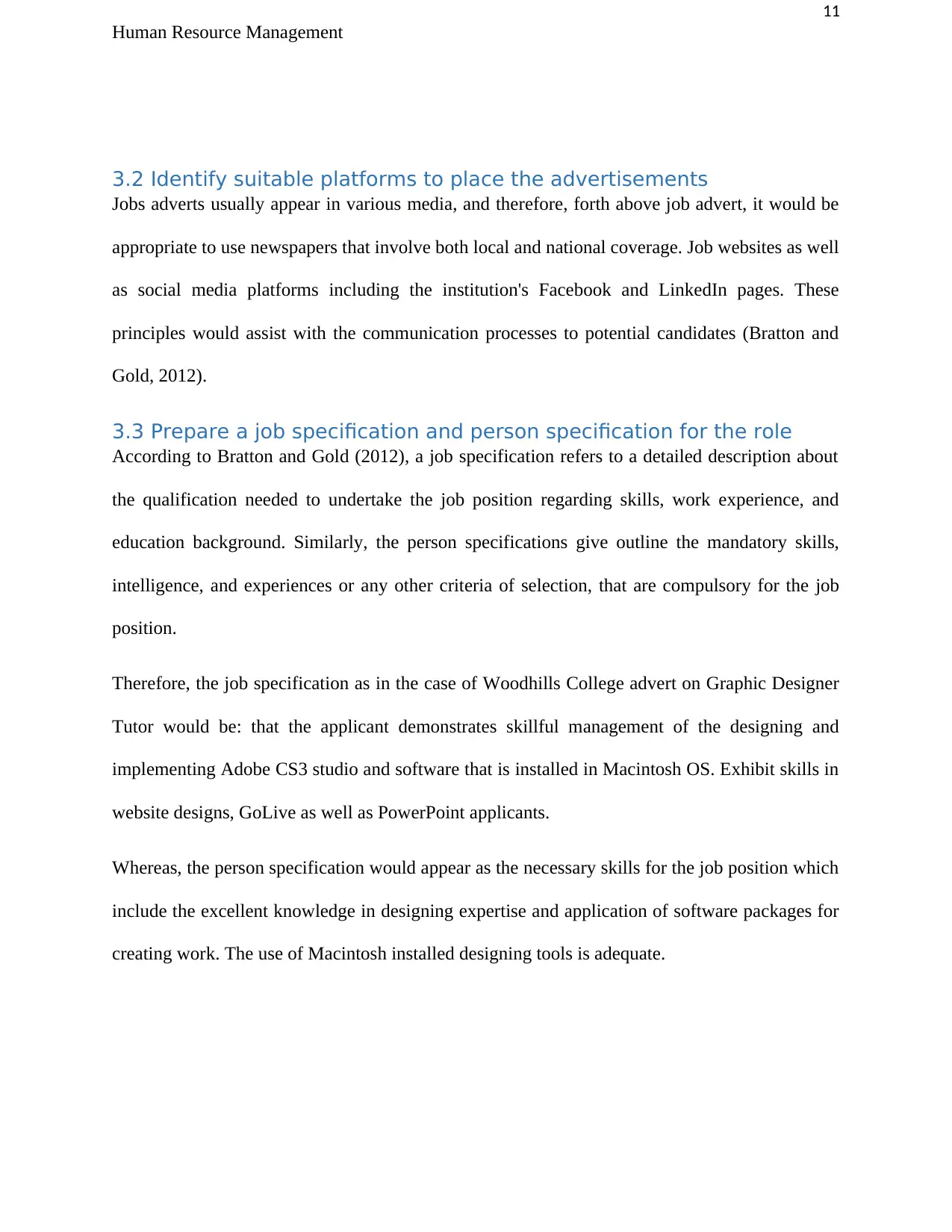
11
Human Resource Management
3.2 Identify suitable platforms to place the advertisements
Jobs adverts usually appear in various media, and therefore, forth above job advert, it would be
appropriate to use newspapers that involve both local and national coverage. Job websites as well
as social media platforms including the institution's Facebook and LinkedIn pages. These
principles would assist with the communication processes to potential candidates (Bratton and
Gold, 2012).
3.3 Prepare a job specification and person specification for the role
According to Bratton and Gold (2012), a job specification refers to a detailed description about
the qualification needed to undertake the job position regarding skills, work experience, and
education background. Similarly, the person specifications give outline the mandatory skills,
intelligence, and experiences or any other criteria of selection, that are compulsory for the job
position.
Therefore, the job specification as in the case of Woodhills College advert on Graphic Designer
Tutor would be: that the applicant demonstrates skillful management of the designing and
implementing Adobe CS3 studio and software that is installed in Macintosh OS. Exhibit skills in
website designs, GoLive as well as PowerPoint applicants.
Whereas, the person specification would appear as the necessary skills for the job position which
include the excellent knowledge in designing expertise and application of software packages for
creating work. The use of Macintosh installed designing tools is adequate.
Human Resource Management
3.2 Identify suitable platforms to place the advertisements
Jobs adverts usually appear in various media, and therefore, forth above job advert, it would be
appropriate to use newspapers that involve both local and national coverage. Job websites as well
as social media platforms including the institution's Facebook and LinkedIn pages. These
principles would assist with the communication processes to potential candidates (Bratton and
Gold, 2012).
3.3 Prepare a job specification and person specification for the role
According to Bratton and Gold (2012), a job specification refers to a detailed description about
the qualification needed to undertake the job position regarding skills, work experience, and
education background. Similarly, the person specifications give outline the mandatory skills,
intelligence, and experiences or any other criteria of selection, that are compulsory for the job
position.
Therefore, the job specification as in the case of Woodhills College advert on Graphic Designer
Tutor would be: that the applicant demonstrates skillful management of the designing and
implementing Adobe CS3 studio and software that is installed in Macintosh OS. Exhibit skills in
website designs, GoLive as well as PowerPoint applicants.
Whereas, the person specification would appear as the necessary skills for the job position which
include the excellent knowledge in designing expertise and application of software packages for
creating work. The use of Macintosh installed designing tools is adequate.
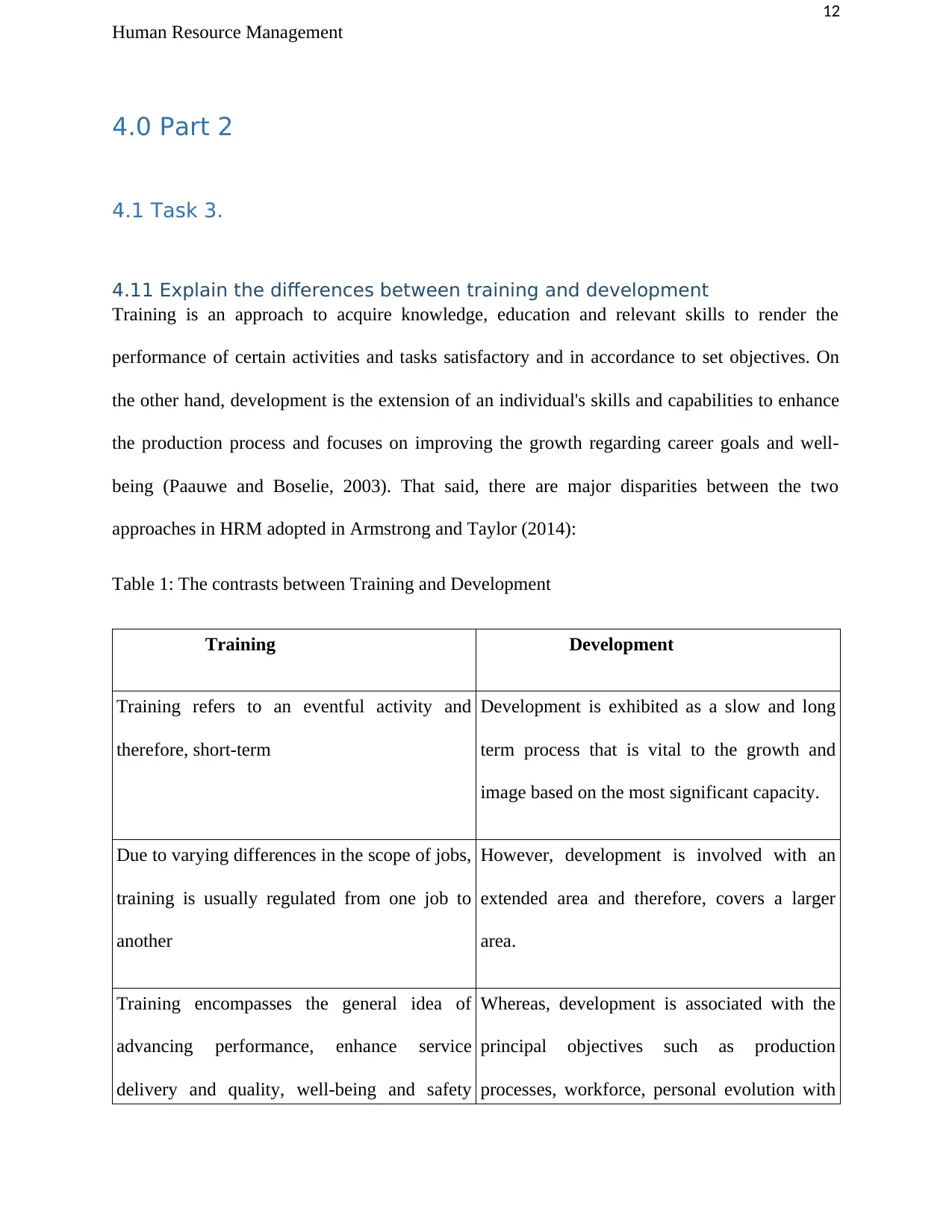
12
Human Resource Management
4.0 Part 2
4.1 Task 3.
4.11 Explain the differences between training and development
Training is an approach to acquire knowledge, education and relevant skills to render the
performance of certain activities and tasks satisfactory and in accordance to set objectives. On
the other hand, development is the extension of an individual's skills and capabilities to enhance
the production process and focuses on improving the growth regarding career goals and well-
being (Paauwe and Boselie, 2003). That said, there are major disparities between the two
approaches in HRM adopted in Armstrong and Taylor (2014):
Table 1: The contrasts between Training and Development
Training Development
Training refers to an eventful activity and
therefore, short-term
Development is exhibited as a slow and long
term process that is vital to the growth and
image based on the most significant capacity.
Due to varying differences in the scope of jobs,
training is usually regulated from one job to
another
However, development is involved with an
extended area and therefore, covers a larger
area.
Training encompasses the general idea of
advancing performance, enhance service
delivery and quality, well-being and safety
Whereas, development is associated with the
principal objectives such as production
processes, workforce, personal evolution with
Human Resource Management
4.0 Part 2
4.1 Task 3.
4.11 Explain the differences between training and development
Training is an approach to acquire knowledge, education and relevant skills to render the
performance of certain activities and tasks satisfactory and in accordance to set objectives. On
the other hand, development is the extension of an individual's skills and capabilities to enhance
the production process and focuses on improving the growth regarding career goals and well-
being (Paauwe and Boselie, 2003). That said, there are major disparities between the two
approaches in HRM adopted in Armstrong and Taylor (2014):
Table 1: The contrasts between Training and Development
Training Development
Training refers to an eventful activity and
therefore, short-term
Development is exhibited as a slow and long
term process that is vital to the growth and
image based on the most significant capacity.
Due to varying differences in the scope of jobs,
training is usually regulated from one job to
another
However, development is involved with an
extended area and therefore, covers a larger
area.
Training encompasses the general idea of
advancing performance, enhance service
delivery and quality, well-being and safety
Whereas, development is associated with the
principal objectives such as production
processes, workforce, personal evolution with
⊘ This is a preview!⊘
Do you want full access?
Subscribe today to unlock all pages.

Trusted by 1+ million students worldwide
1 out of 22
Related Documents
Your All-in-One AI-Powered Toolkit for Academic Success.
+13062052269
info@desklib.com
Available 24*7 on WhatsApp / Email
![[object Object]](/_next/static/media/star-bottom.7253800d.svg)
Unlock your academic potential
Copyright © 2020–2025 A2Z Services. All Rights Reserved. Developed and managed by ZUCOL.





